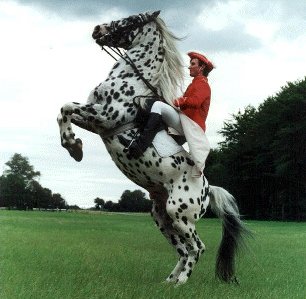Back in 1812 Major Villas Lunn, who resided in Nordsealand, Denmark at the time, put a Fredricksborg stallion to a chestnut blanketed mare (who may have been of Spanish breeding). The resulting colt was colorful and spotted. He would be the foundation for what would eventually become the Knabstrupper.
This unique breed was once favored by kings and dukes across Europe. Frequently used for festivals and pleasure pursuits, the cavalry eventually started using them in Denmark for officer's horses. They were even used in breeding programs on the continent and beyond. One of the founding stallions of the Lipizzaner was a Knabstrupper by the name of Pluto. The end of World War II saw the Knabstrupper used in circus shows throughout the world.
Though the most popular pattern for a Knabstrupper is certainly the full leopard, which involves a full white background covered with bay, black, or chestnut spots, there are other acceptable patterns as well. These include the blanket, the snowcap, and the snowflake. There is also a pattern called the few spot, which is a horse that is almost solid white. When bred, the few spot always produces a spotted foal of some kind.
Standing from 15.2 to 16 hands high, the Knabstrupper actually has three varieties. The Baroque is the traditional horse; it reminds many of old circus horses because many old circus horses were indeed Knabstruppers. The Sport Knabstrupper resulted from a cross with European warmbloods and excels in all of the English sports. The Knabstrupper Pony is just a smaller version of the Baroque and is often used as a children's mount. All of these have great personalities.
Today, the Knabstrupper is primarily seen in dressage, eventing, and show jumping throughout the world. There were no Knabstrupper foals in North America until 2002, but it wasn't until 2003, when the American Knabstrupper Association was formed, that the Knabstrupper had anyone in North American to preserve and promote the breed.
